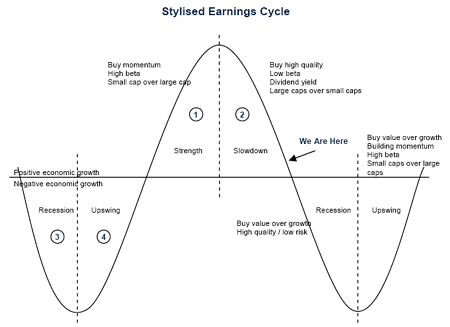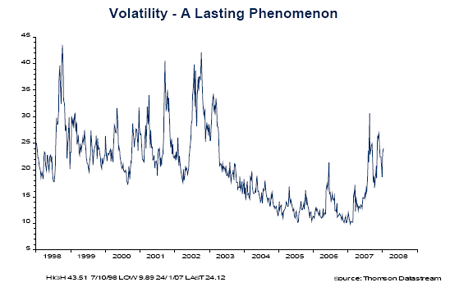2008 has started in remorselessly downbeat mode. Equities are under pressure heading into the Q4 2007 and full year results season, driven lower by hedge fund shorting ahead of what is likely to be a slew of earnings downgrades and negative outlook comments.
Although equity market multiples provide some comfort at face value, based on average earnings across the cycle rather than peak earnings absolute valuations are distinctly less supportive. The macro economic outlook is downbeat.
The US economy appears to have entered recession at some point during Q4 and although a recession is not anticipated, either in the UK or Western Europe, a consumer-led downturn is very much on the cards. Strong bifurcation is evident in early 2008 trading as investors opt for the typically defensive sectors and shun those consumer facing and cyclical sectors regarded as being at the sharp end of the forthcoming slowdown.
MoneyWeek
Subscribe to MoneyWeek today and get your first six magazine issues absolutely FREE

Sign up to Money Morning
Don't miss the latest investment and personal finances news, market analysis, plus money-saving tips with our free twice-daily newsletter
Don't miss the latest investment and personal finances news, market analysis, plus money-saving tips with our free twice-daily newsletter
We expect macro economic activity to trough at some point during Q2 2008 / Q3 2008, ahead of which equity markets are likely to anticipate the bottom and stage a recovery in anticipation of an economic recovery over H2 2008 and into 2009.

With the benefit of hindsight 2007 can now be regarded as the year in which developed Western equity markets shifted from evolving bull phase to mature bull phase. We expect the first half of 2008 to see a continuation of this emergent phase. The over-riding characteristic of late stage bull markets is the extent to which the backdrop is dominated by lower base rates.
Generally, monetary authorities cut rates in order to mitigate an economic slowdown, the consequence of higher base rates in the past which, in turn, were used to deflate earlier bubble environments. Base rate reductions pave the way for the next bubble environment, however, at this stage it is unclear whether a bubble based on the proliferation of exotic financial instruments or credit (both of which are under pressure) can emerge.
Furthermore, a lasting equity market recovery needs the support of the heavyweight financial sectors, especially the banks. Liquidity is being provided by monetary authorities alright but the banks remain the most under-owned sector in the market ahead of results which may reveal balance sheet pressure. In turn, dividend cuts and emergency recapitalisations cannot be altogether ruled out. Once the sector's reporting season passes investors are likely to look again at sector multiples which already reflect a severe economic downturn. However, how long rekindled investor enthusiasm (or short covering) lasts may be determined by the duration of the economic slowdown and the likelihood of further bad news emanating from the credit markets.
Whilst we accept that many portfolios will be so-called "bar belled" (i.e. a mixture of defensive sectors and high beta sectors as a means of hedging against a possible equity rebound) we opt for a more cautious approach for now.
A preference for growth over value
The dominant theme at the moment is the marked preference for growth investing over value. This is understandable as, when economic activity slows, it is much harder for companies to maintain the recent unbroken run of profit growth. Operating leverage is coming under pressure and profit margins, which according to recent data peaked over Q3 2007, are being squeezed. Inevitably earnings growth suffers and 2008 estimates, which had hitherto been largely untouched, are now being cut back.
As operating leverage comes under pressure, so financial leverage increases. Investors increasingly reward those companies which are able to grow top lines in excess of the market in general and which can still show the benefits of operating leverage. In practical terms this means those companies with relatively greater exposure to the still fast-growing economies of the Far East and by extension this implies a preference for larger companies over their medium-sized and smaller counterparts.
The above analysis indicates that not only will large companies perform relatively better than their smaller counterparts in a maturing bull phase, but that amongst large capitalisation companies market leadership is likely to be dominated by fewer sectors. Already the case in 2007, a year in which mining companies carried all before them again, we expect the chase for top line growth and operational leverage to result in a continuation in the trend towards narrower market leadership, particularly over the reporting season.
As an aside, the narrowing market leadership phenomenon is similar to the final upward move the equity market in 1999. Over the period 1999-2002 those companies with low levels of financial gearing ultimately emerged on top. The same is true today. Heading into a downturn with a credit crisis in full swing, the flexibility provided by low financial gearing and reliable cash generation is something investors are inevitably going to prize more highly.
Mid caps more exposed to domestic weakness
Note too, the extent to which medium sized companies have been hit by the latest downward lurch in equity indices. Not only is the mid-cap index more exposed to the weakening domestic economy but also the de-equitisation process which was in full spate over 2006-07 has dried up of late. Private equity was particularly active in the mid-cap arena, however, the credit crunch has left private equity under pressure and in abeyance for now.
Mid-cap equities have de-rated aggressively and bid speculation has departed what were previously inflated valuations and now valuations look much more in tune with operating reality. That said, the results season is expected to bring more earnings disappointment and in consequence we do not believe the de-rating process fully to have run its course.
By contrast, a new animal, the Sovereign Wealth Fund has emerged as an important dynamic in the large cap arena. To be sure, these funds have, to some extent, been attracted / invited to participate by the embattled banking sector, however, their appearance has helped to mitigate the demand / supply disequilibrium created by lack of both retail and professional investor interest.
Higher volatility to become the norm
Whether equities continue to retrench, or rebound as the reporting season progresses investors are inevitably going to have to get used to higher levels of volatility than was the norm just a few years ago. 2004-05 were mid-bull-run years in which volatility levels reached multi-year lows (see chart below). 2006 saw volatility increase and as we all know, it returned strongly in 2007 as the credit crisis broke.
Volatility in itself is not a bad thing, however, investors are going to have to come to terms with often significant intra-day equity market swings which can be more difficult to come to terms with, both psychologically and physically (particularly so when large orders are being transacted).
A deteriorating macro economic backdrop, coupled with continuing difficulties in amongst financials and the steady unwinding of highly leveraged investment positions all indicate that 2008 will not be a year in which volatility returns to the levels of just a few years ago.

Without wishing to over-complicate matters we believe that equities will continue to suffer in the run-up to and during the company reporting season. That over, we suspect that the combination of the liquidity provided by falling base rates and rekindled investor interest (bad news in share prices etc) may encourage a bout of renewed investor interest (or short covering) which could serve to drive share prices higher. Whilst this event would almost certainly provoke cries of "it's all over!" we would be more circumspect.
US economic activity is not expected to trough until Q2 / Q3 08 and whilst equities will almost certainly anticipate this event the latter part of Q1 and early part of Q2 could well be characterised by a return of caution in anticipation of a weak first quarter's trading by corporates. This latter period of caution may well come to be regarded as the moment of equity market capitulation, the point, following which, bullish equity investors ultimately re-assert control.
As a parting shot, investors should note that the long equity bull run began in March 2003. We believe that as equity performance begins to show up in investment funds' five year performance data much will be made of the long-term attraction of equities as an asset class, the moreso given the high profile problems associated with other asset classes such as property, private equity and hedge funds have come under pressure of late. We concur with this view. Although government bonds had a good year, in performance terms, over 2007 and the short end of the bond yield curve may continue to do well (dis-invert) as base rates fall, we suspect that bond gains over 2008 may be harder won. Equities remain the favoured asset class for the medium / longer term.
By Jeremy Batstone-Carr, Director of Private Client Research at Charles Stanley
Get the latest financial news, insights and expert analysis from our award-winning MoneyWeek team, to help you understand what really matters when it comes to your finances.
MoneyWeek is written by a team of experienced and award-winning journalists, plus expert columnists. As well as daily digital news and features, MoneyWeek also publishes a weekly magazine, covering investing and personal finance. From share tips, pensions, gold to practical investment tips - we provide a round-up to help you make money and keep it.
-
 The graphene revolution is progressing slowly but surely
The graphene revolution is progressing slowly but surelyEnthusiasts thought the discovery that graphene, a form of carbon, could be extracted from graphite would change the world. They might've been early, not wrong.
-
 How Javier Milei led an economic revolution in Argentina
How Javier Milei led an economic revolution in ArgentinaFollowing several setbacks, Argentine president Javier Milei's pro-market reforms have been widely endorsed in a national poll. Britain will need the same

